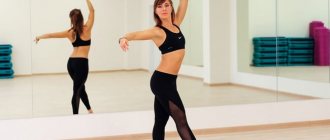| This article may contain original research. Add links to sources, otherwise it may be set for deletion. More information may be on the talk page. (May 11, 2011) |
| This article or section contains a list of sources or external references, but the sources of individual statements remain unclear due to a lack of footnotes. Claims that are not supported by sources may be questioned and removed. You can improve the article by providing more accurate citations to your sources. |
The request for "exercise" is redirected here. A separate article is needed on this topic.
Training
,
training
(English training from train “to train, educate”) is a method of active learning aimed at developing knowledge, skills, as well as social attitudes.
Training is a form of interactive training, the purpose of which is to develop competence in interpersonal and professional behavior in communication.
Training can be viewed from the point of view of different paradigms:
- as a unique form of training, in which, with the help of positive reinforcement, desired behavior patterns are formed, and with the help of negative reinforcement, unwanted ones are “erased”;
- as a form of active learning, the purpose of which is to transfer knowledge and develop certain skills;
- as a method of creating conditions for self-disclosure of participants and their independent search for ways to solve their own psychological problems.
Training of sailors for group survival on the water.
Power training
The goal of this type of exercise is to develop muscle strength as much as possible. Do you want to see sculpted muscles in the mirror? That way. However, you will have to work hard. And the result will depend not only on your perseverance and willpower, but also on how correctly the exercise program was drawn up, whether the diet and daily routine were followed. Strength training has long turned into a lifestyle and has become a whole science, which cannot be mastered without studying the basics of biology.
We list the main types of training of this type:
- Gaining muscle mass.
- Strength endurance and muscle definition.
In each of these subspecies there is an incredible variety of “pumping” programs. Usually they are developed strictly individually, depending on the physiological characteristics of the practitioner’s body.
The main types of training on strength training equipment come down to training different muscle groups: back, pectoral, legs, triceps, biceps, shoulders, abs. At the same time, a training plan is drawn up, where exercises for different types of muscles are grouped. It’s simply impossible to do quality work on your entire body in one workout.
Dance group training
The undoubted advantage of dance classes is that with their help you will not only lose weight, but also receive a charge of vivacity and positivity. In addition, dance-based programs help to reveal flexibility and grace, which is useful in everyday life. It’s true that it’s worth noting that group training in the gym is more geared toward losing weight than developing your dancing abilities.
As a rule, dance group training offers an affordable, moderate-intensity load. As for the complexity of the choreography, it depends on the specific instructor, but most often they focus on the average student. We offer for description only a few areas of dance group training that are more common than others.
DANCE TRAINING: all types
Zumba
Today, Zumba is perhaps the most popular dance style in fitness rooms in the world. It is based on movements from mixed Latin American dance styles.
Zumba group training is characterized by simple choreography, a high fat-burning tempo and very energetic music, so the program is ideal for weight loss and a positive mood. The class is fun and relaxed, making it suitable for beginners. Read more: Zumba fitness: what it is, pros and cons, features and tips.
Belly Dance
Who among us has not admired belly dancing and tried to move our bodies plastically to oriental rhythms? However, Belly Dance not only develops grace, softness and smoothness, but also helps to tighten the stomach, waist, buttocks and thighs.
Belly Dance classes teach basic basic techniques that activate all major muscle groups and improve joint mobility. Belly dancing is also very useful for those who lead a sedentary lifestyle, since hip movements increase blood circulation in the pelvic organs.
Strip Dance/Pole Dance (Strip dance, pole dance)
Strip dancing or half dancing is also called pole acrobatics. To be successful in this type of fitness, you will need endurance, good stretching, strong muscles (especially the upper body) and good overall physical condition. Thanks to pole exercises, you will not only improve your body quality, but you will also be able to develop flexibility, coordination and agility.
In addition to this, pole dancing helps develop flexibility and grace, like any dance training. By the way, strip dancing for beginners may not include exercises with a pole, but will only prepare you for more complex techniques.
Body Ballet
This workout is suitable not only for ballerinas or former dancers, but also for anyone who wants to get a slim, graceful body without problem areas. Some of the exercises in Body Ballet are performed at the barre: you will perform various squats and leg lifts.
Part of the workout takes place on the floor and is an adaptation of low-impact exercises from traditional fitness. This program is especially useful for those who want to work on developing slender legs. Read more: Body ballet: advantages, features, effectiveness.
Dance Mix
Dance Mix, as is obvious from the name itself, is a mixture of various dance styles: hip-hop, jazz-funk, house, breakdancing, r'n'b, freestyle. Such group workouts not only burn calories, but also teach you to move to different musical rhythms and styles.
Modern music, varied choreography, energy in every movement - Dance Mix will give you cheerfulness, relieve tension and fatigue.
Also among dance trainings there are: Latin, salsa, hip-hop, ballroom dancing, breakdancing . Don't be afraid to try a variety of group dance classes if you enjoy that type of fitness. After all, your goal is not to learn all the steps quickly and accurately. Your goal is to get aerobic exercise, burn calories, learn to control your body and get a positive charge of emotions.
Cardio training
It is impossible to imagine the types of workouts in the gym without mentioning the cardio zone. But exercises on these machines have a completely different purpose; you cannot build up muscles on them. But they are much healthier for health. Let's list the benefits of such exercises:
- Increased endurance.
- Strengthening the cardiovascular system.
- Increased lung capacity.
- Maintaining blood pressure levels.
- Reducing cholesterol.
- Improved overall well-being.
Cardio training is often combined with strength training and carried out in parallel.
What exercise machines are cardio-type? There are not many of them, but they are in any sports club:
- Treadmill.
- Exercise bike.
- Orbitrek (elliptical trainer).
- Stepper.
- Rowing machines.
This type of physical activity is ideal for those who want to stay fit and maintain their health.
Short High Intensity Workouts: How Does It Work?
Author: Christina_fitberry.net | Category: – fitness|ARTICLES
I dedicate this article to one of the most frequently asked questions: “Don’t you know that fat begins to be burned only 30 minutes after the start of training?” No, I don't know










